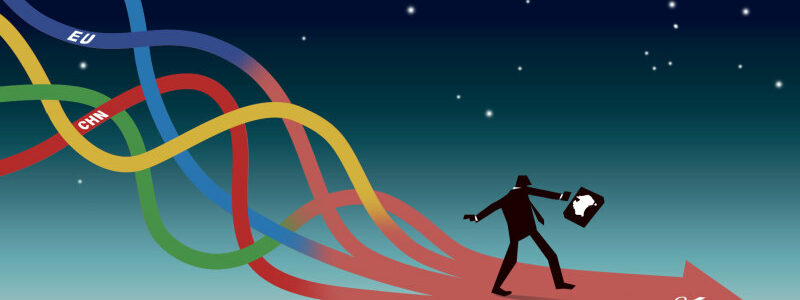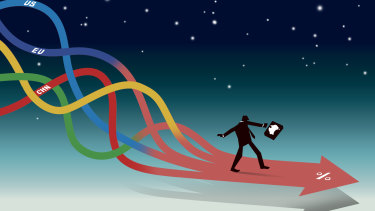
Why we’re stuck with low interest rates for a long time
When it comes to interest rates, we’re living in the strangest of times, with rates lower than ever.
Savers are getting next to no reward for lending their money. Does this make sense? Not really. But we’re moving through uncharted waters and aren’t sure how we’ll get out of them, nor what happens next.
When Reserve Bank governor Dr Philip Lowe appeared before Parliament’s economics committee last Friday, he was asked whether we get the interest rates the world forces on us, or whether our authorities are free to set the rates they want.
Lowe’s answer was “we have the freedom, but we don’t”. Huh? “It’s complicated,” he explained.
Australia’s success rides on being part of the world economy, with larger economies setting the global interest rate. Credit:Matt Davidson
Sure is. What he could have said is that we have some freedom, but not much. Were we to set our interest rates at a very different level to those in the rest of the world, there’d be a price for us to pay.
His own explanation was as clear as mud: we don’t have freedom in a structural sense, but we still have freedom in a cyclical sense.
Let me have a go. Remember that, as part of the process of globalisation over the past 40 years, the rich countries’ national financial markets are now so closely integrated with each other that each country exists in what’s pretty much a single global market, producing a single long-term real interest rate.
Purely by virtue of its big share of the global market, the things an economy as big as the US does can influence the level of the global interest rate. But nothing a middle-size economy like ours does is big enough to move the world rate. We are, as economists say, a “price taker”. We’re free only to take it or leave it.
The market price of something (including the price of borrowing money – the rate of interest) is set by the interaction of demand and supply: how much of it the buyers want to buy, relative to how much the sellers want to sell.
Lowe explained that the reason the “world equilibrium interest rate” has fallen so close to zero since the global financial crisis of 2008 is that, around the world, there’s been an increased desire by people to save, but a reduced desire to invest. That is, savers want to lend a lot more money than investors want to borrow, so interest rates have fallen sharply.
Savers are getting next to no reward for lending their money. Does this make sense? Not really. But we’re moving through uncharted waters and aren’t sure how we’ll get out of them, nor what happens next.
I think by now most economists accept this as the best explanation for the amazing low to which interest rates have fallen. It’s what Lowe means by “structural”. Just why saving is so much greater and investment so much smaller are questions economists are still debating.
Note that this explanation laughs at the standard view in neo-classical economics that saving increases when interest rates are higher, while investment increases when interest rates are lower.
Nor does it fit with the view that the “natural” rate of interest should reflect the rate of business profitability. Although the profits of some businesses have been hard hit by the pandemic, before it arrived – for most businesses – profitability has been high.
An alternative, minority view – pushed by economists at the Bank for International Settlements in Basel, the central bankers’ central bank – is that world interest rates have fallen so low because of the Americans’ excessive use of “quantitative easing” (central banks buying second-hand bonds and paying for them with money they’ve just created) after the global financial crisis and then, once the US economy had recovered, their failure to sell those bonds back to the market and so push interest rates back up.
An economy where households are saving too much of their incomes, and businesses don’t want to invest in expansion, is an economy that’s growing too slowly and not creating many new jobs. The solution, Lowe said, was to give people confidence to spend (and so get their rate of saving down) and give firms the confidence to invest.
How is he doing this? By cutting the official interest rate as close to zero as possible, and using quantitative easing to lower longer-term government and private sector fixed interest rates. Really? Sounds to me like hoping to recover from a hangover by having another drink.
But back to the point. If interest rates ought to be higher to give savers a decent reward on the money they lend, why can’t our central bank set our interest rates higher than those being paid in other parts of the world?
Well, it can. We do retain that freedom. But because our financial markets are just part of the global market, what that would do is push up our exchange rate.
Why? Because financial institutions around the world would shift money into Australian dollars so as to get into our market and take advantage of our higher interest rates. When the demand for “the Aussie” exceeds the supply, the price goes up.
Such a rise in our currency’s rate of exchange against other currencies would reduce the international price competitiveness of our export and import-competing industries, thus reducing our economy’s growth and job opportunities.
That’s the price we’d pay for stepping out of line.
Lowe told the committee that the two main factors that drive the value of our dollar are world commodity prices and relative interest rates – that is, the level of our interest rates relative to other countries’ rates.
The prices we receive for the commodities we export (particularly iron ore) are up but, he said, the Aussie hadn’t appreciated (risen) by as much as you’d expect from past relationships. Why not? Because our lower official interest rates and quantitative easing have narrowed the interest rate “differential” between our rates and the rest of the world.
So, although rising commodity prices have caused our exchange rate to go higher, our quantitative easing has nevertheless caused the dollar to be “lower than it otherwise would be”. Ah. That’s the game he’s playing.
Ross Gittins is the Economics Editor of The Sydney Morning Herald.
Most Viewed in Business
Source: Read Full Article
